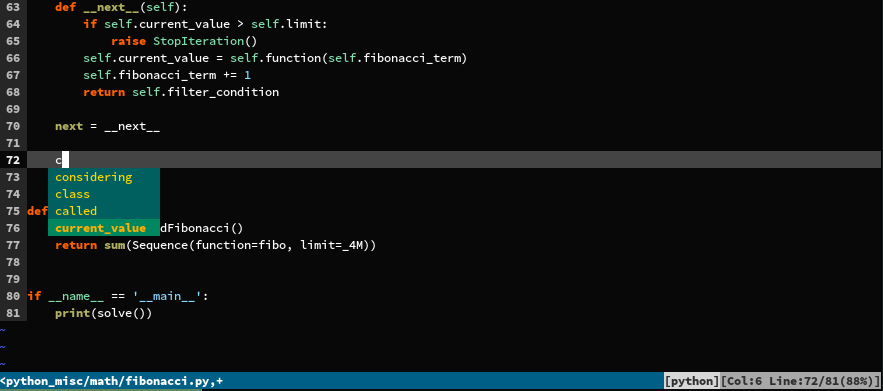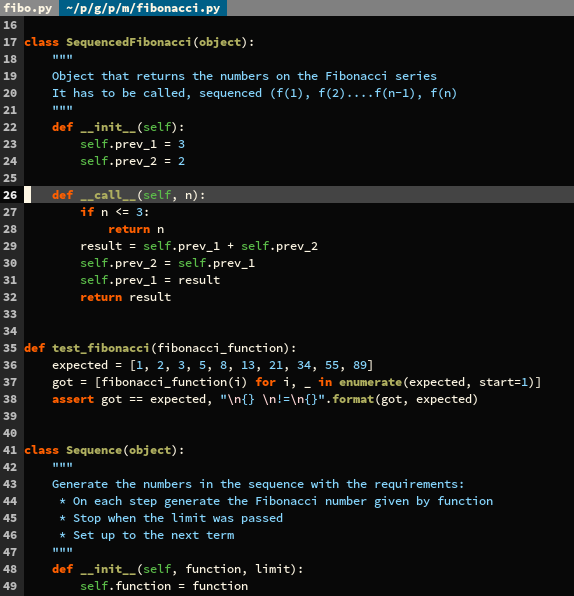This is an ongoing project of that sets up a particular configuration for improved productivity.
The goal is to develop a good configuration for the Vim editor, tailored for Python development.
It does not change the behavior of VIM, since this configuration only adds comfortable shortcuts, and settings that are recommended for software development (coding good practices).
Copy and paste the following command in your terminal:
mkdir -p ~/.vim && wget -O ~/.vim/Makefile -N https://raw.github.com/rmariano/vim-config/master/Makefile && make -C ~/.vim installUse the included Makefile script which downloads and replaces the files on their latest versions. Bear in mind that requires wget and Makefile which comes installed in most of the distributions.
make installOr, if you want to install a particular version (tag or branch).
make install BRANCH=<tag_or_branch>Note: this is supported from version >=v0.4.
The previous methods rely on getting the files from the Internet, but alternatively, if you have already downloaded the project, and unpacked it somewhere in your file system, you can install it by running:
make deployThat will copy the files to their respective locations. Note that this will replace any previous instances of those file you might have had there. If you want to start over, you could simply run make clean, which will remove the files for this project (not the extra packages, though).
The leader key (<leader>) can be customized, but it's mapped to - by default.
<leader>+j: Toggle the margin at the column number set bytextwidth.<leader>+twwill highlight trailing white spaces.<leader>+wwill remove them (they'll also be automatically removed when saving :-)autoindent&smartindent.<leader>+cWill comment out lines of code, and<leader>+uwill uncomment them out. Both apply to normal and visual modes.- Function keys
<F2>: toggle spell check.<F3>: Correct files automatically- XML: auto-format & indent.
- Python: PEP-8, sort imports, format with black, and run
flake8checks.
<F4>: toggle paste mode.<F7>: Run checks in the file (currently only Python is supported).
<leader>+nhas a shortcut for:nohlsearch(No highlight).- A color scheme I like.
- Customizations for certain file types: Python, YAML, XML, and more to come over time.
- A status line with useful information (file name with path, modification flag, file type, column, lines, and position (in %).
;tavailable for searching development tags, such asTODOorFIXME, rendering the results in a quick fix window. Warning: searches recursively.<leader>+n,<leader>+pfor moving to the next and previous entries in the quick-fix window, respectively.<leader>+qfor closing it.<leader>+eto toggle line numbers (enabled by default).- Can save files with
sudothat were opened with less permissions::w!!tosudosave the file. - Mappings for managing tabs
<leader>+tn: Tab New, opens a new tab to the right.<leader>+to: Tab Only, close all tabs but the current one.<leader>+tc: Tab Close, close current tab.<leader>+tm: Tab Move, current to the end.
- Window splits properly configured
- New vertical splits, to the right
<C-j>: for moving between splits (instead of<C-W><C-j>). Same forh,k, orlrespectively.
- Ctrl + `C`: Copy selected content to clipboard.
- Other features
scrolloff=10: offset of 10 lines when scrolling- Performance improvements
- Silent bells
- Set hidden buffers
The color scheme requires the terminal to support 256 colors. Most of the terminals already support this, but some terminal multiplexers like tmux might require to be run as: tmux -2 in order to support this.
In addition, just the command-line classic Vim version is supported, so no support for Gvim or graphical versions is included for the color scheme, although pull requests are welcomed.
Here are some examples of how the color scheme looks like.
Please note this might depend on the configuration of your terminal as well.
If you want to try the project, and tweak the settings, I would recommend you to clone the repository, and use the development deployment, which creates symlinks of the files in this project, like:
make dev-deployIn addition, take a moment to read the contributing guidelines.
- Vim 8+
- Linux, OSX (Other platforms are supported on a best-effort basis).
I prefer to keep the .vimrc configuration as simple as possible, so this project is a collection of settings, configurations, and helpers. That maintains the Vim installation as general as possible.
However, on a daily basis, we might want some extra, few plug-ins.
These are flake8, fugitive vim, and NERDTree.
Please note: The installation of the extra dependencies requires Vim 8.0 or newer, since it install the external projects as packages.
They can be installed with:
make extrasEnjoy!


